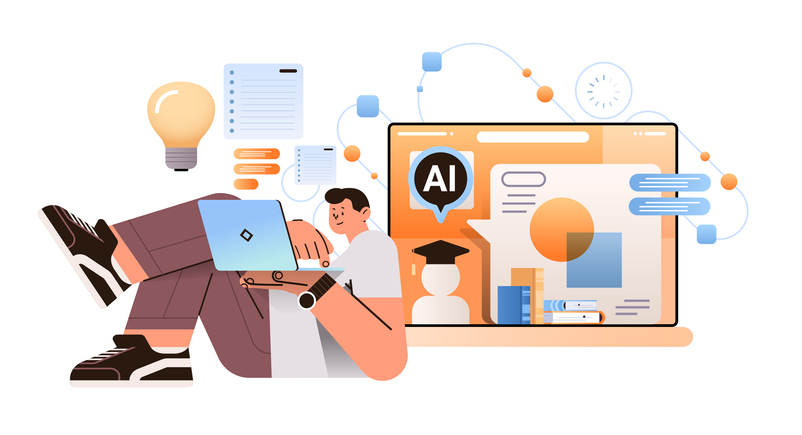During the Webinar of the Observatory of the Institute for the Future of Education (IFE) at Tecnologico de Monterrey, Professor Regina Freyman invited all teachers to explore different generative artificial intelligence tools as an incorporation into the practice of teaching writing. She told us that exploring the new artificial intelligence (AI) tools is transcendental for the future, and we should become familiar with them, know how to use them, and be less judgmental about them, remembering that the main objective is to learn how we can apply these tools to enhance our human intelligence. If you did not have the opportunity to enjoy the live webinar, below is a summary, and you can also check out the webinar at this link: See the complete video here.
“Combining critical thinking, emotional intelligence, and technology is an alternative to develop creative writing that is ethical and critical, emphasizing post-writing.”
Relevance of Critical Thinking and Emotions in the Stories We Tell
New AI technologies can help us improve writing and creating stories; however, we must first know our human capabilities and their full potential to achieve this. Generative artificial intelligence uses algorithms, data, and models that learn and reproduce patterns, but the human mind differs because it feels, experiences, and reflects. In the webinar, Professor Regina provided an intriguing overview of the concepts and capabilities that make us unique as human beings. Awareness of these capabilities can allow us to create and tell better stories.
Human thinking can evaluate, reflect on, and imprint emotion on everything in our lives. There is nothing and no one who can convey this feeling better than each one of us. In the webinar, Professor Regina explained that emotional intelligence and critical thinking are directly and bidirectionally related. Emotional intelligence facilitates critical thinking by regulating our emotions, so we do not misjudge things due to prejudices, impulses, or cognitive biases. It also helps us to be more receptive to the opinions and perspectives of others, to acknowledge uncertainty, and to tolerate ambiguity.
“The human mind differs from generative artificial intelligence because it understands reality, reasons, reflects, creates, and expresses experience emotionally.”
On the other hand, critical thinking enhances our emotional management and helps us to be more aware of our values and beliefs. It helps us question our attitudes and behaviors and look for creative and rational solutions to our problems. Critical thinking and emotional intelligence are skills that complement and nourish each other. Professor Regina commented that if we realize these capacities, we can transmit and tell better stories of our lives, experiences, and relationships with others.
The StoryQ game sparks creative writing.
In this engaging chat, Professor Regina Freyman emphasized that we must teach students to incorporate empathy, compassion, and “the slow or reflective thinking of the human being” (a concept coined by Daniel Kahneman) in their daily lives and stories. Regina explained that, although there are things that machines can do more quickly and accurately than human beings, we must distinguish the times when speed and precision are irrelevant because they are not required at that time. Instead, we need to “retreat a bit” to reflect on the implications of the stories we tell and our choices.
“Critical thinking and emotional intelligence nourish and improve human capabilities so we use information and emotions well.”
In this webinar, Regina Freyman also presented her creation “StoryQ: We are the Stories We Tell,” a game to trigger creative writing. The game comprises the 12 archetypes (leader, magician, seducer, sage, artist, ordinary boy or girl, shadow, etc). It contains three boards representing the stages of 1) the hero’s path, 2) the heroine’s path, and 3) the fairytale path.
The StoryQ game allows creating stories individually or as a team. To do this, the players choose an archetype, an emotion, a desire (obstacle), a gender, and a prompt (a command to guide the generative artificial intelligence). Remember that the more accurate the information entered as a prompt, the better the result; the prompt is so crucial that there are even special courses to learn how to design them. Throughout the game, the student activities of revising, correcting, adapting, ordering, incorporating life experiences, and using metaphors, rhetoric, and sensoriality enrich their post-writing work. According to Regina Freyman, the mission of the new education should be to teach students to recognize emotions, put them into words, and narrate them humanly.
Tools to generate rich stories with artificial intelligence
Regina shared a video during the webinar to illustrate the type of content we can create for classes. Would you like to create similar videos for your courses? Below are the tools she used and their explanations. For more comprehension, we invite you to enjoy the complete webinar.
- Genie: An artificial intelligence chat used to write stories, poems, and song lyrics. (Remember not to enter personal data when using an application of this type for security reasons.)
- ChatGPT: It’s an artificial intelligence chat capable of conversations and generating text requests on any topic. Again, we recommend not entering personal data to secure your information.
- Chat bing: An online search engine from Microsoft helps users find information on the Internet, such as images, videos, news, etc. It can also answer any questions or provide requested information.
- Videoleap: Uses AI to generate images from a text description.
- Restyle: Converts your videos into animated cartoon-style videos with different themes.
- Bard: An artificial intelligence chat that answers your questions through a prompt. (Remember not to enter personal data when using an application of this type for security reasons.)
Have you used any of these apps in your classes? What results did you obtain? What were the opinions of your students? We invite you to share your experiences with us in the comments section.
Relive this webinar. If your native language is not Spanish, you can turn on the YouTube subtitle translations to watch the webinar. To activate this option, select the Subtitles option on YouTube (Spanish subtitles will appear), then select the Settings option ->Subtitles -> Translate Automatically and the preferred language.
Regina Freyman is addicted to stories of all means: words, body language, and images. She studied literature at UNAM, specialized in short stories at IBERO, and has taught at TEC for 15 years. She believes every educational experience must have an artistic dimension to be unforgettable.
This article from Observatory of the Institute for the Future of Education may be shared under the terms of the license CC BY-NC-SA 4.0 
)
)


)